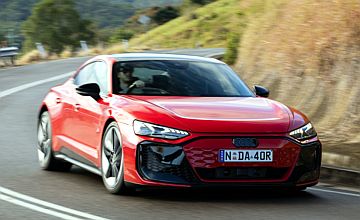Make / Model Search
OptionsCar reviews - Audi - e-Tron - GTAudi modelsOverviewWe like Breathtaking acceleration, hydraulic suspension is a masterstroke, intuitive tech, ergonomic interior layout, engaging without being exhausting, deceptively nimble for such a big heavy brute Room for improvement Road noise intrudes on coarse-chip surfaces, limited interior storage, cramped rear quarters RS E-Tron GT by name, grand tourer by nature; Audi’s updated flagship fits the brief24 Jul 2025 THE Audi RS E-Tron GT Performance arrives as pinnacle of the brand's electric flagship, a mid-life revision to the sleek four-door coupe that leverages rapidly evolving battery electric vehicle technology to crank everything up to eleven without compromising on the nameplate’s promise of grand touring refinement.
Audi wraps its interpretation of the Porsche Taycan’s J1 platform, electric powertrain and sophisticated chassis in more theatrical bodywork with a straightforward but luxurious cabin design that belies the technical tour-de-force beneath.
For Australia, three variants are now offered but given most buyers go for the RS locally, just one example of the entry-level S ($209,900 + ORC) was available during the launch program – which we didn’t have time to try out – and has been upgraded to match the performance of the pre-facelift RS.
Two RS variants are now offered locally: the RS E-Tron GT representing middle child at $264,900 + ORC and the new range-topping RS E-Tron GT Performance at $309,900 + ORC.
Both feature dual-motor all-wheel drive, with the standard RS producing 475kW (630kW with launch control) while the Performance unleashes 680kW when launch control is engaged. Those are serious numbers and a considerable step up from what was available before, translating to 0-100km/h claims of 2.8 and 2.5 seconds respectively.
Our test comprised road driving in a Progressive Red RS E-Tron GT through the Sunshine Coast hinterland, taking in the twisting tarmac between Kilcoy and Montville, plus a brief but memorable acceleration run in the Bedford Green RS E-Tron GT Performance on Lakeside Raceway's main straight.
In addition to the comprehensive driveline overhaul, big news comes in the shape of Audi’s new two-chamber hydraulic suspension system, standard on the RS Performance and optional ($15,900) on the RS E-Tron GT (a carryover air suspension setup is standard on the S and RS).
Courtesy of adaptive wheel-selective electrohydraulic actuators, body pitch and roll are limited to two degrees, while the system quickly raises the vehicle up to 55mm upon door opening for easier entry, exit and luggage loading.
Standard wheel sizes start at 20 inches for the S model, with RS variants riding on 21-inch alloys wrapped in new Italian-made Bridgestone Potenza Sport rubber said to be the brand’s first mass-produced tyre to use 55 per cent recycled and renewable materials.
The S features 390mm front and 358mm rear brake discs with six-piston callipers, while RS models upgrade to tungsten carbide-coated units measuring 410mm front and 365mm rear with 10-piston front callipers.
Carbon-ceramic brakes are optional on RS variants at $13,000, featuring massive 420mm front and 410mm rear discs in a package claimed to save 5kg per corner and “one of the biggest braking systems on an EV in Australia,” Mr Dale claimed.
Inside, all E-Tron GTs feature 18-way electric adjustable tombstone style sports front seats with heating, ventilation and memory functions.
Nappa leather upholstery with honeycomb stitching is standard, while RS variants add massage function and specific design elements.
A new flat-bottom steering wheel incorporates RS mode buttons so the driver can toggle between preconfigured custom settings.
The standard 12.3-inch digital instrument panel plus features RS-specific displays on the top two variants.
Standard technology highlights include matrix LED headlights with laser light function, a 10.1-inch touchscreen infotainment system, a 710-watt Bang & Olufsen 3D sound with 16 speakers, wireless Apple CarPlay and Android Auto connectivity, and a suite of more than 30 driver assistance systems.
The panoramic glass roof features Audi’s new switchable transparency technology on the two RS grades.
As tested, the standard RS we drove wore $297,600 worth of kit including ceramic brakes, active suspension and the RS design package, while the Performance model at Lakeside stretched to $324,400 with its matt carbon camouflage styling package reminiscent of the stunning ‘forged carbon’ finish that debuted on the Lamborghini Sesto Elemento 15 years ago.
Drive Impressions
Having made our way from Brisbane Airport to Lakeside Raceway in the RS Q8 Performance that shared a launch program with the E-Tron GT, our first experience of the latter was to be a drag race style blast up the main straight in the new jewel of Audi’s electric crown.
Enabling launch control is as simple as selecting Dynamic mode (a new steering wheel toggle on the steering wheel providing quick access to a pair of pre-defined, customisable settings called RS1 and RS2), mashing the brake pedal and the accelerator until launch is confirmed in the digital dash and letting go of the brake.
The new suspension’s lack of perceptible squat amplifies the sensation. Powerful BEVs are notoriously – and nauseatingly – quick off the mark but this feels like being launched from a trebuchet.
It’s a sudden, seemingly relentless force that is nothing short of breathtaking to experience. Not exactly enjoyable – once was enough for us – but it was impressive, not least how well the car seemed to stand up to repeated full-bore blasts by the assembled media.
Against the 2.5-second claim, we managed 2.9 seconds according to the in-dash acceleration timer, which was reading 2.8s from the previous participant’s run.
Not bad given we were driving into a stiff headwind; Audi could have easily set up the exercise in the opposite direction to make the most of the conditions but – perhaps as a show of confidence in the product – opted against it.
After driving up to Kilcoy in the RS Q8 Performance it was time to once again swap V8 for electrons, this time for a road run up to Montville and in the regular RS E-Tron, optioned with the hydraulic suspension and carbon-ceramic brakes that come standard on the Performance.
The switch from hulking SUV workstation to low-slung four-door coupe cockpit was surprisingly seamless, not least due to the E-Tron GT’s new ‘access mode’ resulting in it almost hopping up to meet us upon opening a door.
Its swift movement both up and down (once the doors are closed) made us wonder if people might cop a roof to the chin or perhaps a discarded object could get trapped underneath. Underway, supportive seats, good visibility and easygoing flow of the drivetrain and steering also helped ease the transition from bulky V8 to sleek BEV.
An intuitive dash layout, just enough hard buttons including a simple air-conditioning control panel and everything perfectly in reach made settling in a cinch – even adjusting the new hi-tech sunroof that can become opaque in sections or fully frosted with a few taps of the touchscreen.
The main downside is limited in-cabin storage, especially for rear passengers, who are ideally not to be more than about 176cm in height owing to restricted headroom and legroom but otherwise treated to comfy, sculpted seats. By contrast, the boot is big.
It’s rare for such complex cars to be a get-in-and-go proposition but the RS E-Tron GT was just that. It’s also barely changed from the pre-update model, with a more attractive and tactile new steering wheel and a few upgraded finishes to reward the trader-upper without alienating their muscle memory.
Of course, rabid acceleration was only ever an ankle-flex away – heightened in Dynamic mode – but the steering always felt natural and weighted so as to remind the driver of this car’s considerable heft without becoming a workout while communicating the road surface well without being so interactive as to become exhausting. It’s a touchpoint that suits the grand tourer brief to a tee.
That said, road noise was a bit high on the often coarse-chip country roads we were following but Messrs Bang & Olufsen’s 16 speakers, once deployed, ably and joyfully drown that out.
At lower speeds or under heavy acceleration and braking, this car emits one of the most convincing BEV soundtracks on the market. Not trying to sound like a petrol engine, it nevertheless conveys the presence of extreme motive power with a slightly menacing edge.
With regenerative braking now able to send a massive 400kW back into the battery, resulting in enough deceleration for a raft of circumstances, we wondered how much of the carbon-ceramic brakes we were actually using on the public road; certainly we never felt the dead or wooden pedal sensation associated with the technology when cold, which would likely be often given the amount of regen’ possible.
In fact, the brakes felt entirely, impressively natural and the presence of paddle-shifters to control the level of regen’ for some pseudo-engine braking provided a welcome extra layer of interaction over the related Porsche Taycan and its engineering philosophy of eerily coasting on a trailing throttle.
Now for the suspension. Comfort mode was exactly that; absorbent and controlled with far more sensation of the road surface in Dynamic but never jarring.
Regardless of the stiffness level selected, the way the hydraulics almost eliminate pitch and roll make this car feel as though it is almost diving into corners, the eager sensation more typical of a lightweight roadster than a 2.4-tonne BEV.
Rear-wheel steering and that underfloor battery pack’s low centre of gravity add to the deceit by further hiding a mass and footprint similar to that of a Toyota LandCruiser 300 Series; on public roads, only the staggering levels of mechanical grip and traction remind you that this is something far more capable.
That is not to say the RS E-Tron GT is not engaging; the word flow kept coming up again and again during our drive. It’s easy to get into a satisfying rhythm with this car – exactly what you want from a grand tourer.
Comfortable on the straight bits (with excellent massage seats), fun on the twisty bits, capable of obscene speed when the opportunity arises.
All in all, a class act.  All car reviews Alfa Romeo Alfa Romeo Abarth Abarth Audi Audi Aston Martin Aston Martin BMW BMW Bentley Bentley Chrysler Chrysler Chevrolet Chevrolet Dodge Dodge Citroen Citroen Ferrari Ferrari DS DS Ford Ford Fiat Fiat FPV FPV Foton Foton Haval Haval Great Wall Great Wall Honda Honda Holden Holden Hyundai Hyundai HSV HSV Isuzu Isuzu Infiniti Infiniti Jaguar Jaguar Iveco Iveco Kia Kia Jeep Jeep Land Rover Land Rover Lamborghini Lamborghini Maserati Maserati Lexus Lexus McLaren McLaren Mazda Mazda Mercedes-Benz Mercedes-Benz Mitsubishi Mitsubishi Mini Mini Opel Opel Nissan Nissan Porsche Porsche Peugeot Peugeot Ram Ram Proton Proton Rolls-Royce Rolls-Royce Renault Renault Skoda Skoda Saab Saab SsangYong SsangYong Smart Smart Suzuki Suzuki Subaru Subaru Toyota Toyota Tesla Tesla Volvo Volvo |
OptionsClick to share
|









Facebook Twitter Instagram